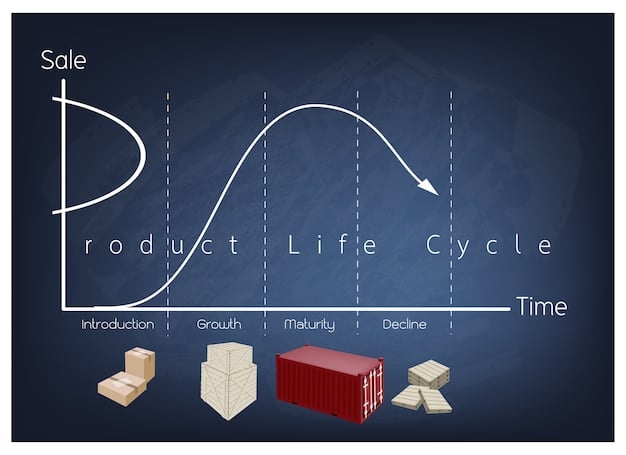E-commerce Platform Shipping: Cut Costs for US Customers by 12%

E-commerce Platform Shipping: Reducing Shipping Costs for Your US Customers by 12% with These Strategies involves optimizing shipping methods, negotiating carrier rates, leveraging technology, and streamlining logistics to enhance profitability and customer satisfaction.
Are you looking to boost your e-commerce business’s bottom line? One of the most impactful areas to focus on is e-commerce platform shipping: reducing shipping costs for your US customers by 12% with these strategies. High shipping costs can be a significant deterrent for online shoppers, leading to cart abandonment and decreased customer loyalty. By implementing strategic changes, you can significantly reduce these expenses, improve customer satisfaction, and gain a competitive edge.
Understand Your Current Shipping Costs
Before implementing any strategy, it’s crucial to understand where your money is currently going. Conducting a thorough analysis of your current shipping expenses will provide a baseline for measuring improvements and identifying areas for optimization.
Detailed Shipping Audit
Start by auditing all your shipping-related expenses. This involves looking at every aspect of your shipping process, from packaging materials to carrier fees. Understanding each component helps in developing targeted strategies for cost reduction.
Software and Tools
Utilize data analytics and shipping software to gain deeper insights into your shipping operations. These tools can track metrics like shipping times, costs per shipment, and common delivery issues, enabling more informed decision-making.
- Analyze historical shipping data to identify trends and inefficiencies.
- Benchmark your shipping costs against industry averages.
- Track shipping expenses by region and product type.
Regularly reviewing and analyzing your shipping expenses will help you fine-tune your strategies and maintain cost-effectiveness. This ongoing evaluation is essential for adapting to changing market conditions and customer expectations.

Negotiate Better Rates With Carriers
Negotiating better rates with carriers is a pivotal strategy for reducing shipping costs. Carriers are often willing to offer discounts to businesses that ship high volumes or can commit to certain shipping schedules.
Leverage Volume Discounts
If your business ships a significant volume of packages, use this as leverage when negotiating with carriers. Explain your shipping volume and inquire about volume-based discounts.
Compare Carrier Options
Don’t limit yourself to a single carrier. Compare rates and services from multiple carriers to find the best deals. Competition among carriers can often lead to more favorable terms for your business.
- Request quotes from multiple carriers like FedEx, UPS, and USPS.
- Consolidate shipments when possible to meet volume thresholds.
- Explore regional carriers for potentially lower rates on local deliveries.
Negotiating rates is an ongoing process. Continually monitor carrier rates and renegotiate as your business grows and your shipping needs evolve. Building strong relationships with carrier representatives can also lead to better service and support.
Optimize Packaging to Reduce Dimensional Weight
Shipping carriers often calculate costs based on either the actual weight of the package or its dimensional weight, whichever is greater. Optimizing your packaging can significantly reduce the dimensional weight and, consequently, your shipping costs.
Right-Size Your Boxes
Use boxes that are appropriately sized for your products. Excessively large boxes increase dimensional weight and can lead to higher shipping fees. Investing in a variety of box sizes can help you minimize wasted space.
Lightweight Packaging Materials
Opt for lightweight packaging materials such as bubble wrap, packing peanuts, or air pillows. These materials provide adequate protection without adding significant weight to the package.

- Switch to lighter-weight cardboard boxes.
- Use inflatable packaging to fill empty space.
- Reduce the amount of tape and other securing materials.
Regularly evaluate your packaging methods to ensure they are both cost-effective and protective. Consider investing in automated packaging solutions for larger operations to further streamline the process and reduce waste.
Offer a Variety of Shipping Options
Offering a variety of shipping options can attract more customers and potentially reduce your overall shipping expenses. Customers appreciate having choices and may be willing to pay extra for faster delivery.
Free Shipping Thresholds
Implement free shipping for orders above a certain threshold to encourage larger purchases. Calculate the threshold carefully to ensure it covers your shipping costs while incentivizing customers to add more items to their cart.
Expedited Shipping
Offer expedited shipping options for customers who need their orders quickly. Charge a premium for this service to cover the higher shipping costs associated with faster delivery times.
- Provide standard, express, and same-day delivery options.
- Offer flat-rate shipping for certain product categories or regions.
- Consider subscription-based shipping programs for loyal customers.
Clearly communicate your shipping options and associated costs on your website. Transparent shipping policies build trust and reduce cart abandonment rates. Consider A/B testing different shipping strategies to find the most effective options for your target audience.
Leverage E-commerce Platform Integrations
Many e-commerce platforms offer integrations with various shipping providers, streamlining the shipping process and potentially reducing costs. These integrations can automate tasks such as rate comparisons, label printing, and tracking updates.
Automated Shipping Calculations
Use platform integrations to automatically calculate shipping costs based on factors like weight, dimensions, and destination. This eliminates manual calculations and ensures accurate pricing.
Real-Time Tracking
Provide customers with real-time tracking updates directly through your e-commerce platform. This enhances the customer experience and reduces inquiries about order status.
- Integrate with shipping APIs for automated rate shopping.
- Use shipping management software to streamline workflows.
- Employ tools that optimize routing and delivery schedules.
Regularly update your e-commerce platform integrations to take advantage of the latest features and improvements. These integrations can significantly reduce manual labor, improve efficiency, and lower shipping costs over time.
Consolidate Orders and Ship in Bulk
Consolidating orders and shipping in bulk can lead to significant cost savings. By combining multiple orders into a single shipment whenever possible, you can reduce the number of individual packages and lower overall shipping fees.
Order Batching
Batch similar orders together to minimize handling and packaging time. This is particularly effective for businesses that sell a variety of small items.
Strategic Warehousing
Consider using multiple warehouses strategically located across the country to reduce transit times and shipping distances. This can be particularly beneficial for reaching customers in different regions efficiently.
- Offer incentives for customers to combine multiple items into a single order.
- Use fulfillment services to manage inventory and shipping.
- Optimize warehouse layout for efficient order processing.
Implementing a robust order consolidation strategy requires careful planning and coordination. However, the potential cost savings and improved efficiency make it a worthwhile investment for e-commerce businesses of all sizes.
Utilize Regional Carriers
While national carriers like FedEx and UPS dominate the shipping landscape, regional carriers can offer more competitive rates for deliveries within specific geographic areas. Exploring these options can lead to significant cost savings, especially for local or regional businesses.
Research Local Options
Investigate regional carriers that operate in your target markets. These carriers may have lower overhead costs and can offer more flexible pricing options.
Compare Rates and Services
Compare the rates and services of regional carriers with those of national carriers. Consider factors such as delivery times, service guarantees, and customer support.
- Negotiate custom rates with regional carriers.
- Use regional carriers for local deliveries and national carriers for long-distance shipments.
- Build relationships with regional carrier representatives for personalized support.
Integrating regional carriers into your shipping strategy can provide a valuable competitive edge. By diversifying your carrier options, you can optimize your shipping costs and improve delivery times for customers in key markets.
| Key Point | Brief Description |
|---|---|
| 📊 Audit Costs | Analyze shipping-related expenses to identify areas for optimization. |
| 📦 Optimize Packaging | Use right-sized boxes and lightweight materials to reduce dimensional weight. |
| 🚚 Negotiate Rates | Leverage volume and compare options to get better deals with carriers. |
| 🤝 Regional Carriers | Explore local carriers for competitive rates in specific regions. |
Frequently Asked Questions
▼
Start by auditing all shipping-related expenses, including packaging materials, carrier fees, and handling costs. Use data analytics and shipping software to track metrics like shipping times and costs per shipment, providing a comprehensive baseline.
▼
Leverage volume discounts by highlighting your shipping volume. Compare rates from multiple carriers like FedEx, UPS, and USPS to find the best deals. Consolidate shipments to meet volume thresholds and build strong relationships with carrier representatives.
▼
Optimizing packaging reduces dimensional weight, a key factor in shipping cost calculations. Use appropriately sized boxes and lightweight materials like bubble wrap or air pillows to minimize wasted space and lower shipping fees.
▼
Integrations with shipping providers automate tasks like rate comparisons, label printing, and tracking updates. They also provide real-time tracking for customers, enhancing their experience and reducing inquiries about order status.
▼
Yes, regional carriers often offer more competitive rates for deliveries within specific geographic areas. Research local options and compare their rates and services with those of national carriers to find the best options for your business.
Conclusion
Reducing shipping costs is crucial for maintaining profitability and enhancing customer satisfaction in the competitive e-commerce landscape. By understanding current expenses, negotiating with carriers, optimizing packaging, and leveraging technology, businesses can achieve significant savings and provide a better overall experience for US customers.





